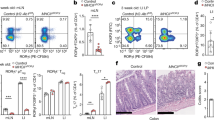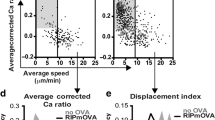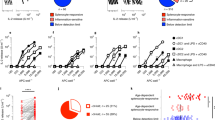Abstract
Recognition of self-antigen-derived epitopes presented by major histocompatibility complex class II (MHC II) molecules on thymic epithelial cells (TECs) is critical for the generation of a functional and self-tolerant CD4 T-cell repertoire. Whereas haematopoietic antigen-presenting cells generate MHC-II–peptide complexes predominantly through the processing of endocytosed polypeptides1, it remains unknown if and how TECs use unconventional pathways of antigen presentation. Here we address the role of macroautophagy, a process that has recently been shown to allow for endogenous MHC II loading2,3,4,5,6, in T-cell repertoire selection in the mouse thymus. In contrast to most other tissues, TECs had a high constitutive level of autophagy. Genetic interference with autophagy specifically in TECs led to altered selection of certain MHC-II-restricted T-cell specificities and resulted in severe colitis and multi-organ inflammation. Our findings indicate that autophagy focuses the MHC-II–peptide repertoire of TECs on their intracellular milieu, which notably comprises a wide array of otherwise strictly ‘tissue-specific’ self antigens7,8. In doing so, it contributes to T-cell selection and is essential for the generation of a self-tolerant T-cell repertoire.
This is a preview of subscription content, access via your institution
Access options
Subscribe to this journal
Receive 51 print issues and online access
$199.00 per year
only $3.90 per issue
Buy this article
- Purchase on Springer Link
- Instant access to full article PDF
Prices may be subject to local taxes which are calculated during checkout




Similar content being viewed by others
References
Trombetta, E. S. & Mellman, I. Cell biology of antigen processing in vitro and in vivo . Annu. Rev. Immunol. 23, 975–1028 (2005)
Schmid, D., Pypaert, M. & Munz, C. Antigen-loading compartments for major histocompatibility complex class II molecules continuously receive input from autophagosomes. Immunity 26, 79–92 (2007)
Paludan, C. et al. Endogenous MHC class II processing of a viral nuclear antigen after autophagy. Science 307, 593–596 (2005)
Nimmerjahn, F. et al. Major histocompatibility complex class II-restricted presentation of a cytosolic antigen by autophagy. Eur. J. Immunol. 33, 1250–1259 (2003)
Dorfel, D. et al. Processing and presentation of HLA class I and II epitopes by dendritic cells after transfection with in vitro-transcribed MUC1 RNA. Blood 105, 3199–3205 (2005)
Dengjel, J. et al. Autophagy promotes MHC class II presentation of peptides from intracellular source proteins. Proc. Natl Acad. Sci. USA 102, 7922–7927 (2005)
Kyewski, B. & Klein, L. A central role for central tolerance. Annu. Rev. Immunol. 24, 571–606 (2006)
Anderson, M. S. et al. Projection of an immunological self shadow within the thymus by the Aire protein. Science 298, 1395–1401 (2002)
Starr, T. K., Jameson, S. C. & Hogquist, K. A. Positive and negative selection of T cells. Annu. Rev. Immunol. 21, 139–176 (2003)
Aschenbrenner, K. et al. Selection of Foxp3+ regulatory T cells specific for self antigen expressed and presented by Aire+ medullary thymic epithelial cells. Nature Immunol. 8, 351–358 (2007)
Gallegos, A. M. & Bevan, M. J. Central tolerance to tissue-specific antigens mediated by direct and indirect antigen presentation. J. Exp. Med. 200, 1039–1049 (2004)
Klein, L., Roettinger, B. & Kyewski, B. Sampling of complementing self-antigen pools by thymic stromal cells maximizes the scope of central T cell tolerance. Eur. J. Immunol. 31, 2476–2486 (2001)
Tewari, M. K., Sinnathamby, G., Rajagopal, D. & Eisenlohr, L. C. A cytosolic pathway for MHC class II-restricted antigen processing that is proteasome and TAP dependent. Nature Immunol. 6, 287–294 (2005)
Zhou, D. et al. Lamp-2a facilitates MHC class II presentation of cytoplasmic antigens. Immunity 22, 571–581 (2005)
Levine, B. & Klionsky, D. J. Development by self-digestion: molecular mechanisms and biological functions of autophagy. Dev. Cell 6, 463–477 (2004)
Mizushima, N., Yamamoto, A., Matsui, M., Yoshimori, T. & Ohsumi, Y. In vivo analysis of autophagy in response to nutrient starvation using transgenic mice expressing a fluorescent autophagosome marker. Mol. Biol. Cell 15, 1101–1111 (2004)
Kuma, A. et al. The role of autophagy during the early neonatal starvation period. Nature 432, 1032–1036 (2004)
Mizushima, N. et al. Dissection of autophagosome formation using Atg5-deficient mouse embryonic stem cells. J. Cell Biol. 152, 657–668 (2001)
Rossi, S. W. et al. RANK signals from CD4+3- inducer cells regulate development of Aire-expressing epithelial cells in the thymic medulla. J. Exp. Med. 204, 1267–1272 (2007)
Gray, D., Abramson, J., Benoist, C. & Mathis, D. Proliferative arrest and rapid turnover of thymic epithelial cells expressing Aire. J. Exp. Med. 204, 2521–2528 (2007)
Derbinski, J. et al. Promiscuous gene expression in thymic epithelial cells is regulated at multiple levels. J. Exp. Med. 202, 33–45 (2005)
Huang, J. & Klionsky, D. J. Autophagy and human disease. Cell Cycle 6, 1837–1849 (2007)
Tourne, S. et al. Selection of a broad repertoire of CD4+ T cells in H-2Ma0/0 mice. Immunity 7, 187–195 (1997)
Ignatowicz, L., Kappler, J. & Marrack, P. The repertoire of T cells shaped by a single MHC/peptide ligand. Cell 84, 521–529 (1996)
Nakagawa, T. et al. Cathepsin L: critical role in Ii degradation and CD4 T cell selection in the thymus. Science 280, 450–453 (1998)
Murata, S. et al. Regulation of CD8+ T cell development by thymus-specific proteasomes. Science 316, 1349–1353 (2007)
Murphy, D. B. et al. A novel MHC class II epitope expressed in thymic medulla but not cortex. Nature 338, 765–768 (1989)
Pua, H. H., Dzhagalov, I., Chuck, M., Mizushima, N. & He, Y. W. A critical role for the autophagy gene Atg5 in T cell survival and proliferation. J. Exp. Med. 204, 25–31 (2007)
Hampe, J. et al. A genome-wide association scan of nonsynonymous SNPs identifies a susceptibility variant for Crohn disease in ATG16L1 . Nature Genet. 39, 207–211 (2007)
Rioux, J. D. et al. Genome-wide association study identifies new susceptibility loci for Crohn disease and implicates autophagy in disease pathogenesis. Nature Genet. 39, 596–604 (2007)
Klein, L., Klein, T., Ruther, U. & Kyewski, B. CD4 T cell tolerance to human C-reactive protein, an inducible serum protein, is mediated by medullary thymic epithelium. J. Exp. Med. 188, 5–16 (1998)
Kirberg, J. et al. Thymic selection of CD8+ single positive cells with a class II major histocompatibility complex-restricted receptor. J. Exp. Med. 180, 25–34 (1994)
Acknowledgements
We acknowledge support from the Austrian National Science Fund (Sonderforschungsbereich F023 and grant Z58-B01 ‘Wittgenstein Prize Meinrad Busslinger’; to J.N. and L.K.) and the European Union (FP6 Integrated Project ‘Eurothymaide’; Contract LSHB-CT-2003-503410; to M.A., J.E. and L.K.). Research at the Research Institute of Molecular Pathology is funded by Boehringer Ingelheim. We thank C. Spona for technical assistance and M. Busslinger, M. S. Anderson, B. Kyewski and J. Derbinski for comments on the manuscript. We also thank H. Ploegh for discussions in the earliest phase of this project.
Author Contributions J.N. was involved in all experiments (assisted by J.E., M.A. and L.K.). M.A. carried out the analysis of TRA expression. J.N., N.M. and L.K. designed experimental strategies. J.N. and L.K. wrote the manuscript. All authors discussed and commented on the contents of this manuscript.
Author information
Authors and Affiliations
Corresponding author
Supplementary information
Supplementary Information
The file contains Supplementary Figures 1 - 11 and Supplementary Tables 1 - 2 with Legends. (PDF 798 kb)
Rights and permissions
About this article
Cite this article
Nedjic, J., Aichinger, M., Emmerich, J. et al. Autophagy in thymic epithelium shapes the T-cell repertoire and is essential for tolerance. Nature 455, 396–400 (2008). https://doi.org/10.1038/nature07208
Received:
Accepted:
Published:
Issue Date:
DOI: https://doi.org/10.1038/nature07208
This article is cited by
-
Mitochondrial protein C15ORF48 is a stress-independent inducer of autophagy that regulates oxidative stress and autoimmunity
Nature Communications (2024)
-
FEZF2 and AIRE1: An Evolutionary Trade-off in the Elimination of Auto-reactive T Cells in the Thymus
Journal of Molecular Evolution (2024)
-
Autophagy: a necessary evil in cancer and inflammation
3 Biotech (2024)
-
B cells orchestrate tolerance to the neuromyelitis optica autoantigen AQP4
Nature (2024)
-
Exploiting autophagy balance in T and NK cells as a new strategy to implement adoptive cell therapies
Molecular Cancer (2023)
Comments
By submitting a comment you agree to abide by our Terms and Community Guidelines. If you find something abusive or that does not comply with our terms or guidelines please flag it as inappropriate.



